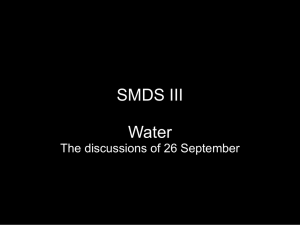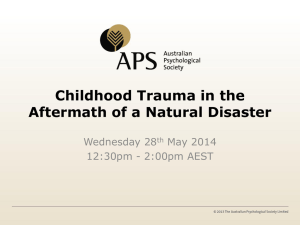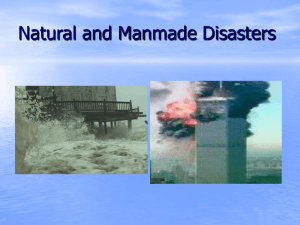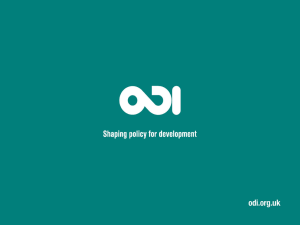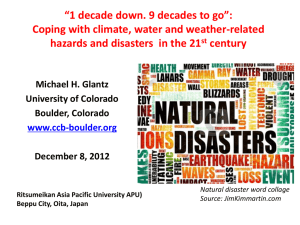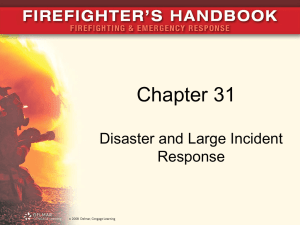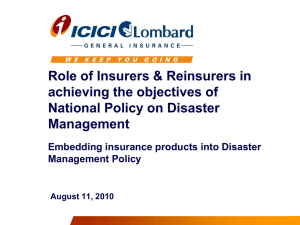Supporting Children after Disasters and Crisis
advertisement
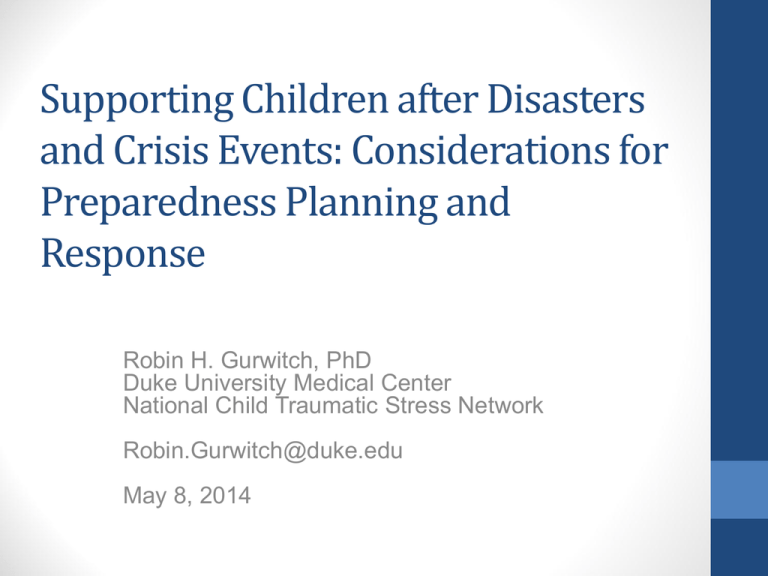
Supporting Children after Disasters and Crisis Events: Considerations for Preparedness Planning and Response Robin H. Gurwitch, PhD Duke University Medical Center National Child Traumatic Stress Network Robin.Gurwitch@duke.edu May 8, 2014 Please do not duplicate without express permission of the author. Thank You, Robin H. Gurwitch, PhD Traumas that can touch our lives • Accidents • Child Abuse and Neglect • Community violence • Dog Bites • Domestic Violence • Economic Stressors (Severe) • Hostage Situations • Medical Illness • Murder • Natural Disasters • Parent/Caregiver Death • School Shootings • Sexual Abuse and Rape • Substance abuse • Terrorism and other man-made disasters • War Why Learn About Mental Health Issues after Trauma, Disasters, Public Health Emergencies? • Current worry among adults and children today • Personal traumas touch children on a regular basis • Being prepared increases resilience in face of crisis Key Concepts for Disaster Mental Health? • Disasters impact individuals as well as communities • Disasters touch individuals directly as well as indirectly • Disasters have phases which require varying responses • Disaster stress reactions are “normal responses to abnormal situations” • Practical assistance vs. traditional psychotherapy • Services must keep in mind the community and the phase of the disaster • Recognition of support systems available • Understanding of impact on responders Psychological Issues with Invisible Agents, Including H1N1 • • • • • • • “Walking Worried” Increased fear of the unknown and unseen Fear and anxiety contagion Unique exposure threats Unknown treatment regimen Fear of medical environment HAZMAT suits and decontamination CDC Assumptions with Pandemic Flu • Initial responsibility with domestic outbreak rests with state, local, territorial, and tribal authorities • Increased likelihood of gaps in public service and safety • Existing healthcare capacities in the US will be overwhelmed, resulting in an increasingly large number of deaths • Increase in public anxiety will cause increased psychogenic and stress related illness compounding the strain on the health care facilities • Significant number of non-citizen and uninsured citizens will need public health and medical intervention • Restrictions in travel, home, school, work, public transportation, and large gatherings. Pandemic Illness and Planning • How is this planning different from other disaster planning? • What information is appropriate to be shared? • We have little evaluation of educational material. Areas to Address • • • • Medical System Emergency Response Public Health How do we link Behavioral Health planning with general emergency planning in each of these areas as Behavioral Health Preparedness is very limited Emotional Care After Disasters • Health Care Professionals of all types provide vital care-Public/Behavioral Health: Physicians, Psychologists, Nurses, Social Workers, Aides, Clergy, Community Counselors • Each delivers psychosocial care to address emotional distress-the goal of any kind of terrorism and the effect of disasters Early Ideas About Trauma and Children • Children’s reactions were mild • Children’s reactions were transient • No interventions were needed Impact of Trauma and Disasters on Children • Academics • Feelings and reactions • Communication • Pre-existing challenges become worse Impact of Trauma on Learning • Decreased IQ and reading ability • Lower grade-point average • Higher school absenteeism • Increased expulsions and suspensions • Decreased rates of high school graduation Possible Trauma Reactions Among Children • Worries and Fears • Changes in Behavior • Physiological Responses • Focus on Event • Spiritual Changes WORRIES AND FEARS • Increased worries and fears about safety of self and others • Increased worries and fears about security • Worries and fears about re-occurrence of the event • Worries about on-going situation Guilt and Shame • Common feelings • About actions taken • About actions not taken • About the person(s) who died/ hurt • In response to own thoughts and feelings CHANGES IN BEHAVIOR • • • • • • • • • Changes in school performance Decreased concentration Decreased attention Changes in sleep Changes in appetite Changes in mood (swings) Changes in activities Increased irritability Increased anger outbursts or temper tantrums • Increased withdrawal • Increased hate talk/play PHYSIOLOGICAL RESPONSES • Increased sensitivity to sound • Increased startle response • Increased somatic complaints • Headaches • Stomachaches • Fatigue • Vague aches and pains FOCUS ON EVENT • Repeated questions about event • Repeated discussion or story-telling about the event • Increased interest in media coverage (TV, print, internet) • Trauma Reminders • Loss Reminders Changes in Spirituality • Changes in relationship with and/or beliefs about a higher power • Increased or decreased involvement in spiritual activities • Questioning of beliefs • Struggle with sense of fairness • Struggle with understanding Factors That Can Make A Difference • Level of exposure • Loss • Media • Separation from parents • Age and level of understanding • Disruption of routine • Parental adjustment • Premorbid functioning • Family functioning and stressors • Social and community supports Factors That May Increase Risk Death of a family member or friend Seeing serious injury or the death of another person Missing family members Getting hurt or becoming sick due to the disaster Worrying about becoming sick Being unable to evacuate quickly or becoming trapped Losing your home, job and/or belongings; having to relocate and changing schools or neighborhoods Having past traumatic experiences Suffering an injury/illness related to the disaster Feeling extreme panic or that your life was in danger Losing a pet Dealing with financial burdens (source: PsySTART Triage System, Schreiber, 2010) Range of reactions to disaster • Wide range of reactions and concerns Not just PTSD • Bereavement • Secondary losses and stressors • • • • • • • • Relocations Loss of peer network Loss of network of supportive adults Loss of community Academic failure Integrating into new social network (bullying) Financial stresses Parental stress Why Not Just Ask Parents, Caregivers, or Teachers? Adults generally UNDERESTIMATE Children’s reactions and levels of stress Reasons for Underestimation • Parents/Teachers do not know what to look for in children’s reactions to traumatic events • Parents/Teachers “hope and pray” that their children are doing well • Parents’/Teachers’ level of distress makes it difficult to recognize the signs in their children • Some reactions can’t be seen • Children try to hide their reactions and stress from parents/teachers because they do not want to upset parents/teachers • Teachers feel pressured to “get back to routine” • Communication may be poor What is Psychological First Aid? • The practice of recognizing and responding to people who need help because they are feeling stress, resulting from the disaster situations within which they find themselves. • American Red Cross Psychological First Aid • Emotional support • Information and education • Answer frequently asked questions • Encourage practical & adaptive ways of coping • Early recognition of core mental health problems & referral A New Model for Psychological First Aid for Children Listen, Protect, Connect Model and Teach Available at: http://www.ready.gov/kids/_downloads/PFA_Parents.pdf FOR ALL CHILDREN: REMEMBER… Listen, Protect, Connect, Model and Teach And EXPECT RECOVERY! Interventions • Trauma-Focused Cognitive Behavioral Therapy (TF-CBT) • www.musc.edu • Cognitive Behavioral Interventions for Trauma in Schools (CBITS) • www.nctsn.org • Healing After Trauma Skills (HATS) • www.nctsn.org • Listen, Protect, and Connect (Model and Teach): Psychological First Aid for Parents (and Teachers) • www.ready.gov • Skills for Psychological Recovery • www.nctsn.org


